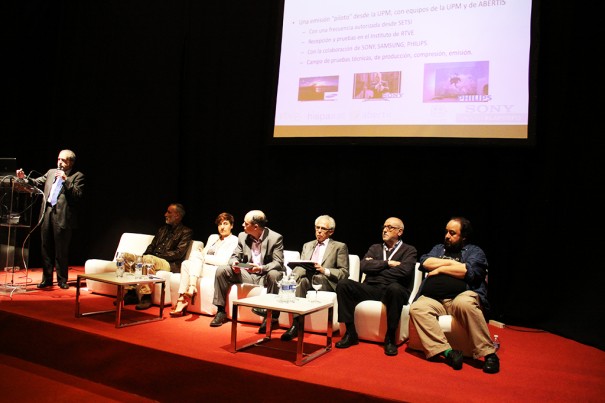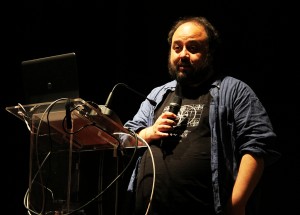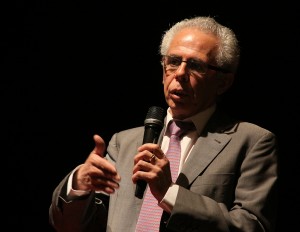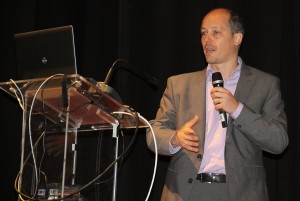La Pasión del Prado se muestra en BIT Broadcast 2014 como la “marca España” del 4K
El documental La pasión del Prado sigue siendo el gran representante de la producción 4K española y, evidentemente, no podía faltar en este Salón Internacional de la Tecnología Audiovisual. Los principales involucrados en este proyecto, RTVE, Abertis, Hispasat, Sony, Sapec y Apuntolapospo, se han reunido en una mesa redonda para explicar cómo ha sido la evolución de este proyecto.
Los principales agentes involucrados en este proyecto se han dado cita en IFEMA para explicar cómo surgió la idea y cómo ha ido desarrollándose el proyecto hasta convertirse en una auténtica producción 4K con una gran repercusión a nivel mundial.
Para explicar a los asistentes cómo ha sido la realización y evolución de proyecto, se han reunido en una mesa redonda Juan Carlos González de RTVE, Xavier Redón de Abertis, Miguel Ángel Cristobal de Sapec, Inés Sanz de Hispasat, Paul Turrents de Sony y José María Aragonés de Apointlapospo.
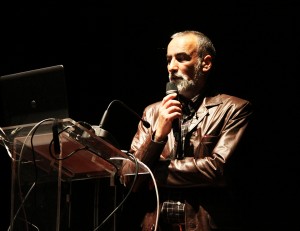 Para conocer sus orígenes hay que remontarse a la prueba piloto realizada en Barcelona hace ya dos años, iniciativa que dio paso al actual documental que se está exhibiendo. Se trataba de un corto que giraba en torno a la Ciudad Condal y mostraba el urbanismo, la arquitectura singular y sus entornos. Más tarde esta experiencia, se trasladó a las salas del Museo del Prado.
Para conocer sus orígenes hay que remontarse a la prueba piloto realizada en Barcelona hace ya dos años, iniciativa que dio paso al actual documental que se está exhibiendo. Se trataba de un corto que giraba en torno a la Ciudad Condal y mostraba el urbanismo, la arquitectura singular y sus entornos. Más tarde esta experiencia, se trasladó a las salas del Museo del Prado.
“Decidimos que fuera el Museo de El Prado el objeto de este primer proyecto 4K ya que el arte nos permite mostrar todo lo que puede ofrecer esta tecnología. Es un contenido que nos permite aprovechar la definición y calidad del color de la ultra alta definición. Además, es una manera de llevar la joya de la cultura española más allá de nuestras fronteras. 4K ha venido para quedarse. Tenemos la tecnología, ahora hay que desarrollarla y unirla a la marca España”, explica Juan Carlos González.
Esta ha sido la primera producción que TVE ha realizado con esta tecnología pero en su cartera están previstos otros proyectos que verán la luz a lo largo de este año y el que viene. “El primero que estamos haciendo gira alrededor de la música, Jordi Savall. Para después del verano tendremos preparado un documental sobre El Greco y ya para final de año esperamos haber acabado el de Altamira, la primera catedral del arte, aunque este último está resultando más complicado ya que es una producción muy ambiciosa que plantea grandes retos. Para 2015 y aprovechando el quinto centenario de Santa Teresa de Jesús tenemos previsto realizar una producción en torno a este tema, titulada Dios entre pucheros”.
Para realizar este documental, un equipo de TVE recorrió las salas del Museo del Prado para acercar a los espectadores la magia y la luz de 400 obras maestras de las más de 9.000 que atesora el Museo del Prado. El objetivo del documental es dar una visión completa de la pinacoteca madrileña, mostrando la historia y creación del Museo y las distintas colecciones que en él se encuentran expuestas. El 4K permite una resolución que imita la realidad y ofrece gran calidad en la percepción del color y las texturas, fundamental en la reproducción de obras de arte.
Hispasat y Abertis, que han patrocinado la producción del documental, han proporcionado los medios técnicos necesarios para el desarrollo del proyecto, junto a la productora Apuntolapospo, a cargo de la edición y postproducción del documental, con los recursos de producción, como la cámara Sony F65, de la compañía Ovid, que capturó las imágenes en 4K. TVE se ha hecho cargo de la organización, producción, dirección y realización de todo el proceso de grabación.
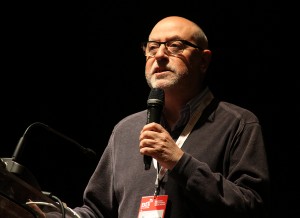 “La cámara Sony F65 está equipada con sensor CMOS de 8K con el que pudimos hacer un trabajo más cercano al cine que a la televisión. Nos permitía conseguir que el rodaje fuera lo más sencillo posible y, además, nos facilitaba la graduación del color. En la producción que estamos haciendo tendemos a monitorizar en 4K y a realizar la corrección del color desde la propia cámara”, comenta Paul Turrents.
“La cámara Sony F65 está equipada con sensor CMOS de 8K con el que pudimos hacer un trabajo más cercano al cine que a la televisión. Nos permitía conseguir que el rodaje fuera lo más sencillo posible y, además, nos facilitaba la graduación del color. En la producción que estamos haciendo tendemos a monitorizar en 4K y a realizar la corrección del color desde la propia cámara”, comenta Paul Turrents.
Tras realizar los contenidos, la siguiente fase era la producción, conseguir que todo ese trabajo filmado en 4K pudiera ser visualizado la misma calidad y características que aporta esta tecnología. “Con lo últimos avances que se han conseguido podemos trabajar de forma no lineal, aleatoria, multiformato y de forma simultánea. En el caso de El Prado, el montaje, grafismo y sonido se realizó directamente en las estaciones de TVE. Realmente, en composición sólo se hicieron algunos pequeños efectos. Por su parte, las exhibiciones se hicieron con una resolución de 3840×2160 a 10 bits, en RGB, y con un aspecto de ratio de 1:85”, aclara José María Aragonés.
Para Miguel Ángel Cristobal de Sapec el principal problema se encontraba en los sistemas de comprensión ya que “actualmente, hay muy pocas redes que permitan este tipo de transmisión y podíamos llegar a muy pocos usuarios. La solución la encontramos en el nuevo formato de comprensión, HEVC-ITU H.265”.
El formato HEVC mejora la eficiencia de comprensión en un 50% y permite soportar nuevos formatos de mayor resolución como UHDTV.
Desde la primera experiencia realizada en Barcelona, hasta la actual versión que se fue exhibida en la pasada edición de Canmes se ha conseguido pasar de los 25 fps a 50 fps, se ha evolución del sistema de codificación H-.264 al H.265 y “hemos conseguido aprovechar las actuales infraestructuras de TDT y satélite. Además, ahora también contamos con nuevos dispositivos que permiten que 4K sea una realidad”.
La intervención de Xavier Redón ha puesto de relieve el gran avance que ha sufrido la TDT “que no ha parado de incorporar mejoras y el último paso ha sido el 4K. El uso de los contenidos se realiza en canales lineales y para poder ver 4K ha habido que realizar una serie de cambios tecnológicos que nos permitan ver con una mayor resolución y, para eso, ha sido fundamental la codificación HEVC (H.265), con modulación DVB-T2, lo que nos permite alcanzar los 30/33 Mbps”.
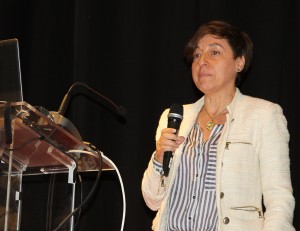 En la transmisión que se realizó de La pasión del Prado en el MWC de este año ya se hizo a 50 fps con compresión HEVC y modulación DVB-T2. Por su parte, la exhibición en el IBC 2013 se transmitió por satélite “y supuso el lanzamiento desde Hispasat en 4K. A partir de este momento, nuestro objetivo era crear un canal abierto para el colectivo audiovisual que está desarrollando en 4K. En NAB 2014 hemos ampliado nuestra cobertura a Norteamérica con amazonas 3 y, ahora con Hispasat IC la hemos ampliado aún más a Latinoamérica”, dice Inés Sanz.
En la transmisión que se realizó de La pasión del Prado en el MWC de este año ya se hizo a 50 fps con compresión HEVC y modulación DVB-T2. Por su parte, la exhibición en el IBC 2013 se transmitió por satélite “y supuso el lanzamiento desde Hispasat en 4K. A partir de este momento, nuestro objetivo era crear un canal abierto para el colectivo audiovisual que está desarrollando en 4K. En NAB 2014 hemos ampliado nuestra cobertura a Norteamérica con amazonas 3 y, ahora con Hispasat IC la hemos ampliado aún más a Latinoamérica”, dice Inés Sanz.
Did you like this article?
Subscribe to our NEWSLETTER and you won't miss anything.



